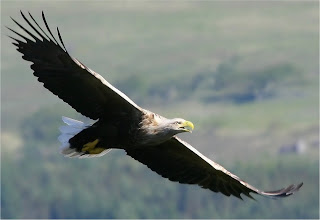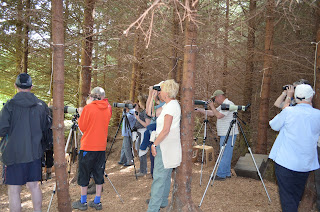 |
| Mull's White Tailed Eagles |
The first white-tailed eagle chick of the year at the
Mull Eagle Watch hide has been spotted by rangers.
It’s hopeful that a
second egg is in the nest and that the proud parents,
Iona & Fingal, will have another chick to look after in couple of days.
For the past 38 days, the adult birds have taken turns in incubating the eggs, sitting very low on the nest.
First indications that something had changed was on Tuesday this week when the female was sitting higher up on the nest. She was also fidgeting and fussing with the eggs so it was clear that a new arrival was coming.
Sue Dewar, White-Tailed Eagle Ranger with Mull & Iona Ranger Service said:
“We are thrilled to bits at the news and we are keeping our fingers crossed that all goes well with the remaining egg.
“It was on Wednesday afternoon that we first witnessed Iona, the female adult, bending her head down and gently feeding the chick.
“Tiny morsels of food were torn off by her huge beak and were delicately fed to her new chick. Iona was also very careful to keep her talons well out of the way so as not to put the chick in any danger.
”The new arrival is great news for the birds but also for Mull as so many people come to witness these massive and magnificent birds.”
Fingal, the male, was not seen during the afternoon the new chick arrived and was most likely to be off hunting to feed his new family.
If the female takes a break from her new duties the male adult will take over until she returns. If there is a second egg it could hatch in the next couple of days, as eagles lay eggs two or three days apart, but sit from the time the first egg is laid.
Dave Sexton, RSPB Scotland’s Mull Officer added:“Whilst breaking out of the egg is one of the toughest parts of an eagle’s life, the next 10 days is also critical as they must be brooded by an adult at all times to avoid hypothermia. So Mull Eagle Watch and the CCTV will still be running 24/7 to ensure Fingal & Iona and their new family are not disturbed in any way”
Mull Eagle Watch is run by a partnership consisting of Forestry Commission Scotland, Mull & Iona Community Trust, RSPB Scotland, Scottish Natural Heritage and Strathclyde Police.
Part of the income from trips to the hide is put into a fund which is available to the islanders for local community projects. A recent survey reported that the white-tailed eagles alone bring in
£5m annually to Mull’s economy, which is hugely important to the island.
All over the island, Mull Eagle Watch’s dedicated team of volunteers have been watching the eagles’ nests to ensure that no-one gets too close as the birds will leave the nest if they are disturbed by anyone – deliberately or inadvertently.
Because the Mull Eagle Watch are constantly on the lookout for egg thieves, nests are watched for 24 hours a day and this year CCTV is also being used with other high-tech equipment to back up our volunteers.
Once the chicks are hatched there are still problems from the very occasional photographer who wants to get closer than is comfortable for the birds, and two such people were prosecuted last year for ignoring instructions not to go too close. Fortunately on that occasion the chick survived, but only because volunteers and police reacted quickly.
The hide at
Glen Seilisdeir is open Monday to Friday from April to the end of September, running two trips a day. White-tailed eagle rangers will tell the story of the eagles’ extinction and subsequent reintroduction, and then escort visitors to an outdoor viewing hide just 300m from the nest.
Booking is essential on 01680 812556.
 Our new site at Glen Seilisdeir has proved to be a wonderful venue with great views of our Sea Eagle nest, a very popular open-air viewing hide and plenty of happy visitors.
Our new site at Glen Seilisdeir has proved to be a wonderful venue with great views of our Sea Eagle nest, a very popular open-air viewing hide and plenty of happy visitors..jpg) Today is my last day for this season, although as I live on Mull I'll be keeping an eye on our eagles during the winter months - it's impossible to stay away! Fingal, Iona, Buidhe and Gorm are doing well (as are Skye, Frisa and Sunda) and all the other Sea Eagles on Mull - it's been a record year. Other raptors on the island have done well too, thanks largely to the lovely summer we have enjoyed - for once Scotland's west coast has enjoyed better weather than the rest of the UK.
Today is my last day for this season, although as I live on Mull I'll be keeping an eye on our eagles during the winter months - it's impossible to stay away! Fingal, Iona, Buidhe and Gorm are doing well (as are Skye, Frisa and Sunda) and all the other Sea Eagles on Mull - it's been a record year. Other raptors on the island have done well too, thanks largely to the lovely summer we have enjoyed - for once Scotland's west coast has enjoyed better weather than the rest of the UK.



























